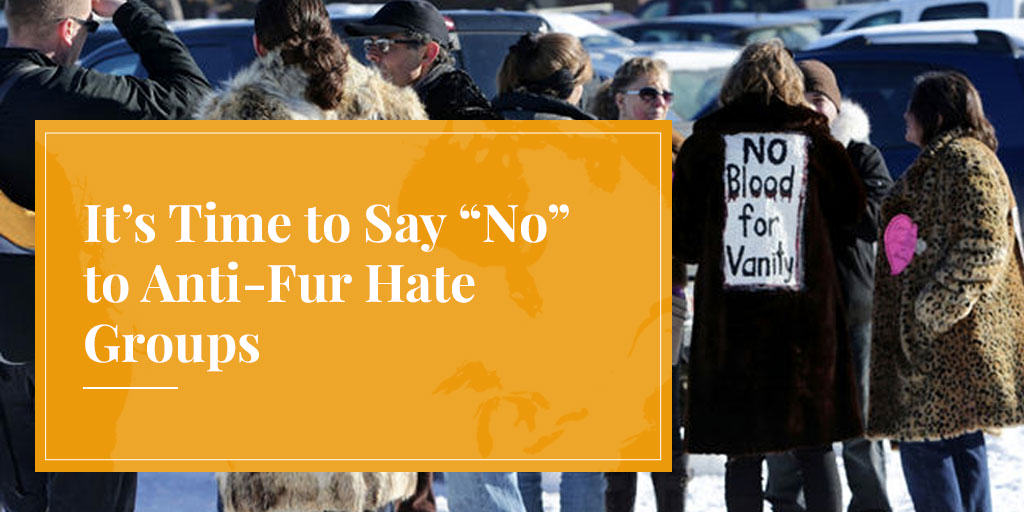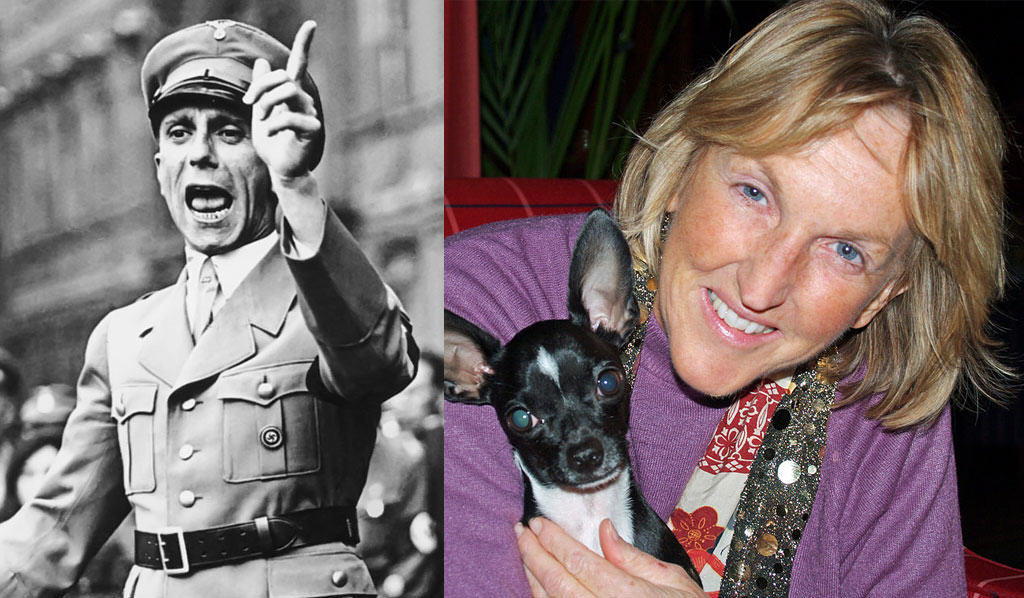
Now that recent actions by White Supremacists and Neo-Nazis have sparked discussion about the importance of tolerance in a modern, multi-cultural society, perhaps it is time to denounce another type of increasingly aggressive hate group: animal-rights extremists.
I can hear animal activists choking on their tofu stir-fry, but the facts speak for themselves: their campaigns – like those of other hate groups – almost always involve a direct attack on the rights, reputation and livelihoods of other people.
Hate groups are usually defined as organizations that promote discrimination against specific groups of people based on their race, religion, gender or sexual orientation. It’s time we added “employment” to that list.
Think about it: animal activists are not satisfied with expressing their opinions or exercising their right to wear cotton, hemp and synthetics, rather than fur or other animal products. Instead, they seek to impose their views on everyone.
While they call for compassion, they often seem to be driven more by anger and hatred of people who don’t share their views.

They use sensationalist and misleading videos of dubious origin to smear the entire fur industry and everyone associated with it – the same sort of tactics employed by other hate groups. The Nazis, of course, pioneered the use of staged films to fan hatred against Jews and others.
And if propaganda doesn’t work, animal extremists – like other hate groups – aren’t shy to employ intimidation. Despite decades of misleading activist campaigning, fur is now being sold in a wider range of stores than ever, in designer collections, as trim on outerwear, in fashion accessories. If consumers agreed with the activists’ condemnation of fur, stores wouldn’t be selling it. But animal extremists do not think that consumers and retailers have a right to make such decisions for themselves.
Their response is rowdier demonstrations. Fur-wearing consumers are harangued as they enter or leave stores; they are followed down the street by angry activists. Stores are warned that the demos won’t stop until they drop fur from their offerings. Under cover of darkness, store windows are broken and locks are glued. So much for the respectful exchange of views.

The animal extremist message is clear: “Do as we say, or face the consequences.” Like a mafia protection racket. Or a chilling echo of the threats and intimidation used against businesses that resisted segregationist thugs in the early days of the US Civil Rights Movement.
Elevating Animals, Degrading People
The aggressiveness of animal-extremists is fueled by their fundamentalist “animal-rights” philosophy. If you believe that killing a mink (or a cow, pig or chicken) is the moral equivalent of killing a fellow human, it is easy to justify the most radical of actions.
SEE ALSO: Why Animal Rights Activists Are Becoming More Aggressive
Unfortunately, rather than elevating the moral status of animals, such beliefs easily lead to the degradation of other people. Once again, the Nazis provide a stark warning: not only were Hitler and several of his top henchmen vegetarians, but the Third Reich was the only national government in history to implement a complete ban on the use of animals in medical research. Dr. Josef Mengele used Jews instead for his cruel experiments.
In fact, most people in our society accept the responsible use animals for food, clothing, and other purposes. As designer Karl Lagerfeld has said about activists protesting his use of fur: “For me, as long as people eat meat and wear leather, I don’t get the message.”
We have shown in a previous article, “Why fur is the ethical clothing choice”, that the modern fur trade fully satisfies the four criteria required for most people to accept the use of animals as ethical. The wild-fur trade is well regulated and sustainable. Research and standards promote animal welfare for both wild and farmed fur-bearers. Fur animals are fully utilized with minimal waste. And the fur trade supports rural and remote communities while providing a valuable and long-lasting natural clothing material.
I know that most “animal-rights” advocates will be shocked at being labelled as hate mongers; they will claim that they are promoting justice, not discrimination. But every hate group claims to be promoting justice for their own particular cause. Having a cause does not justify attacking the reputations and livelihoods of people who do not share your beliefs.
It is time that the people of the fur trade were recognized for their knowledge and skills in maintaining this remarkable heritage industry, and for developing one of the most responsible and sustainable animal-use industries in the world.
And it is time for the media, political leaders, and the general public to take a much harder look at the misguided and irresponsible actions of animal extremists – and to say “no” to hate groups of all stripes.











I am very sick and tired of people telling us who wear fur we are evil. I have done my research and only purchase furs that are trapped or farmed with the proper labeling which is country of origin. I actually pay hundreds to thousands more per garment ensuring the furs I purchase Are legal and have cities certification which means not endangered species. Also on a personal level I do not purchase fur from Asian countries the quality is lesser and I need assurance of the furs origins. Us and farmed raised animals and trappers have strict guidelines and regulations to abide by. I eat meat and have several leather goods and leather interior in my car to me there is no difference. Also biproducts from mink farms are being used to make bio fuels for city buses And fur is biodegradable. My family have fought to keep the us a free country and I have the right choose what to wear And buy. I am a very self conscious educated fur consumer. So please just be respectful my family has paid a heavy price to keep our country free which is why animal acitivists have the right to protest. I will tell you activists though the average consumer are getting tired of your groups imposing your views in not a nice way and the PETA people if you do your research in Virginia at there animal shelter they have the highest kill rate. Look it up yourself through the state of Virginia and read the comments of why honest pet vets stopped donating animals to PETA, because they are killing them. Do your own research on this it really is eye opening!
Who’s paying you, dude?
How can you be okay with condemning animals to torture and death? Have you ever seen how they get fur? Animals live in tiny filthy cages which is horrible enough, and then they electrocute them through their “rear end”. I understand some animal groups are extreme about it but how can you be okay with an innocent animal being tortured like that? That’s sick.
Hi Joe, rest assured we are very aware “how they get fur”, since all Truth About Fur staff and contributors have extensive hands-on experience in the fur trade. If you want to understand how we’re “okay” with this, please take some time to explore our website. Our page on ethics might be a good place to start: https://truthaboutfur.com/ethics-of-fur
Have you ever seen how they get fur? Not propaganda sent to you by an “activism” group, but actually gone personally and witnessed yourself with your own eyes how they get fur?
If not then you have no right to denounce someone else for not having “seen how they get fur”.
The simple fact is that fur is unnecessary in this day and age.
As an industry, it directly supports needless suffering. Every unbiased individual with a heart and brain knows this. Therefore it is against the basic precepts of moral reasoning and clashes with any ethical value system worth considering.
Claims of hypocrisy aimed at vegans do nothing at all to justify the violence that trappers, and fur industry minions perpetuate knowingly and deliberately. Nice try though.
Claims that fur is more sustainable are laughable when viewed in context of the vastly more sustainable practice of veganism.
This site does a skillful job of creating a specious, superficially plausible (yet actually false) pro fur case. However, as one scratches beneath the surface of the fur advocacy B.S. with a little critical thinking and intelligence, this feeble, fragile case for fur withers away entirely in the light of reason – exposing it’s proponents as mercenary shills and debased, depraved supporters of vile cruelty.
As you are aware, and no doubt the reason you created this website, you can be certain that this will not stand and will not go unchallenged by the public once they see continuously mounting video evidence of the carnage. Reason and compassion will inevitably prevail.
I see the future on a tombstone.
Rest in Peace Fur industry. You tried, and died.
The Fur Industry will NEVER die because Millions of men and women choose to wear fur and leather and NO amount of BS peta flag waiving groups will NEVER bring it down. I for one and Im SURE there are many more will never dictate to me what to wear. I know I am not a heartless person you vegan/peta folks like to portray us because we wear fur. GET OVER IT and go find a cure for Cancer and Aids and feed the Hungry and Homeless.
Hells yeah!!
This is positively sick. How can you compare the Nazi’s to people who are concerned for animal welfare? Fur trade may be a persons livelihood, yes, but it IS also undoubtedly the unnecessary killing of animals for their skin. You cannot deny that. Humanity does not NEED animal fur to exist. Someone protesting for the lives of animals is so vastly far off from Nazi propaganda, it actually makes me feel nauseous to see that comparison. There are many many occupations in the world that surround controversial issues, and the whole world is never going to agree on which side of those issues are correct, and which are not. If you want anyone to respect your position, pulling a low blow like comparing PETA to the Nazi movement is quite far off from where you should be. Downright despicable.
It is perfectly understandable that you find this comparison offensive, in the same way that many Jews (and others) found PETA’s “Holocaust on a plate” campaign offensive. It is important to understand that this blog post is not directed at people who are simply concerned about animal welfare standards. It also does not refer to the people who believe in animal rights, but express their beliefs in a way that is acceptable to society at large and does not promote intolerance. But those on the front line of dealing with the animal rights movement will tell you that spreading “hate” is now central to much animal rights propaganda. In this sense, the comparison to Nazi propaganda is valid.
I agree that spreading hate for any cause is wrong…and sadly many causes from small to nationwide are spreading that message these days. Which is why I think it’s all the more important for those persons who don’t believe in that message, to be really careful about the language they use. Do you not think that by comparing animal rights protestors to Nazi’s, that you are setting some groundwork for feelings of anger and hate in many people?
I don’t support the fur trade. I also don’t support violence or hate as a method of putting those feelings out into the world. I came across this post while doing some research, and as someone of Jewish heritage it really offended me. I think there is a way to calmly and eloquently state the facts that you are presenting without doing something like drawing a comparison between people pushing the boundaries for animals, and people trying to wipe out an entire race of humans. I am sorry…but there is no comparison. There are extremist groups of people that push things too far in many areas, animal rights being one of those many. I think you could make your case against those few extremists…not all animal rights activists, without comparing them to a group responsible for slaughtering millions.
Animal rights activism IS extremism, and they all deserve to be treated as such. Animal welfare activism is completely different, and that is a very respectable cause. But the animal rights movement believes that animals should not be used for food, clothing, as pets, support animals, for entertainment, or for medical testing. That would mean no more new medical advancements because every single major medical advancement to this day is thanks to testing on animals. These people are extremists and rely on terrorist actions to advance their cause. And if you are offended by the Nazi reference, then you should be much more offended by the constant comparison of livestock farming to the holocaust.
If you read the article more carefully, you will see that the point being made was that the Third Reich did, in fact, endorse “animal rights” policies, including a complete ban on the use of animals in medical research, the only government that has ever done so. If being reminded (informed?) of this fact makes you feel nauseous, so much the better, because maybe that’s the first step to thinking about the real implications of ideologies that seek to accord animals the same moral status as humans. And, yes, we understand that most “animal rights” supporters see themselves as peaceful people — but, no matter how strongly we feel about certain issues, it is important to also respect the views and choices of people who have different opinions. What we are criticizing in this article is the increasingly aggressive and intolerant tone in animal-rights campaigning.
Anti-cruelty and social justice activists are actually peaceful people promoting a just, peaceful, cruelty planet for all regardless of race, religion, sex, gender, age, or species.
We believe in equality for all. This article does not accurately portray 99% of animal rights activists and there are thousands of videos out there at this point of animals being skinned alive.
One incident of ALF /ELF extremism from years ago does not speak for the millions of global activists. Please open your hearts and your minds – we only want peace for all.
Hi Sandra, peaceful protests against cruelty and social injustice are commendable, but in our experience, animal rights activists (not animal welfare) all too often forget the “peaceful” part. Fortunately, militant animal rights activists probably only number in the thousands world-wide, but they do manage to make their presence felt and are a problem all livestock farmers must contend with.
Meanwhile, you say there are “thousands” of videos out there of animals being skinned alive. We believe this is a myth, at least where the fur trade is concerned. Most that we’ve seen are just recycled videos with nothing to do with the fur industry. We are only aware of one video that shows raccoon dogs being skinned alive for their fur in China, and a thorough investigation found that this video was almost certainly staged. If you know of a video that shows animals being skinned alive, specifically for their fur, and that has nothing to do with raccoon dogs in China, please send a link to [email protected] and I guarantee we will look into it.
Thank you! I took part in the largest peaceful demonstration against fur this past weekend in Oslo, Norway. We are gathering to protect the rights of living beings that do not have a voice. No animal wants to be caged, bleeding from their feet because they walk on wire cages, to then sometimes be skinned alive, or killed by anal or vaginal electrocution. The fact this page is even in existence trying to make this barbacious act seem “ok” it absurd. NO animal needs to be farmed, caged, to then be murdered to feed the narcissistic behavior of humans. NO TO FUR!
You make it all sound so terrible, Della, except when you call us “barbacious”, which we believe means to look like a Barbie doll. The truth is that on regulated fur farms in North America, the animals receive a very high level of care, and are NEVER skinned alive. To understand why it is absurd to say this happens, please read: https://truthaboutfur.com/5-reasons-animals-are-not-skinned-alive/
There is ALWAYS going to be people who wear fur WHAT is wrong with you animal activists?? Its NONE of your business WHAT I wear, I CHOOSE to wear fur/leather and if any of you people came up to me waving your signs and bullied me I would probably wind up in jail beating YOUR ass!! Go find a cure for Cancer/Aids/Child Abuse/Hungry People/Homeless/should I list MORE serious issues?? Fashion will ALWAYS use REAL fur so you people are wasting your time because I for one will NEVER stop wearing or buying fur.
hate is hate + should be criminalised in my view.
animal rights groups are anti-science, anti-fur, anti-people’s rights.
they shouldn’t be allowed to go any further than express their opinions in a proper debate.
I’m only school age but they definitely don’t represent my views.
I do like real fur, I do support animal-testing for science + safety, I ALWAYS put people’s rights before animal rights!! 🙂
A beautiful article. Here we see the need to educate. I also have to say that the pictures shown by the activists are unsightly, if one asks for the origin of the pictures, so it can answer one, very strange.
We should continue to use fur because it is a really beautiful, sustainable material, which we use. I could write much more, for today it is sufficient.